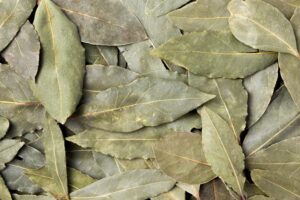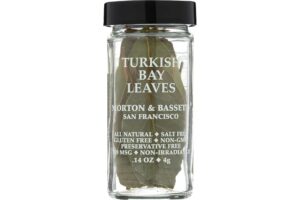Bay leaves may appear small and unassuming in the kitchen, but their effect on dishes goes a long way. They have had an impact on the flavor, aroma, and cultural history of meals across diverse cuisines.

Bay leaves are indisputably a culinary staple. However, a valid question most people ask is, are there even different types of bay leaves?
Yes, and Turkish bay leaves and California bay leaves are regularly used in seasoning. However, they have their differences.
Comparisons Between Turkish and California Bay Leaves
Turkish Bay Leaves
Turkish bay leaves are the more commonly found variety in most markets. They tend to have a milder flavor with slightly minty and herbal notes.
They are often used in Mediterranean cuisines and are known for their ability to add a subtle thickness to dishes without overpowering them.
California Bay Leaves
California Bay leaves are stronger and more pungent in flavor compared to Turkish bay leaves. They have a more intense, almost eucalyptus-like taste, which can be somewhat bitter.
California bay leaves are used sparingly in cooking due to their potency. They are also often used in West Coast American cuisines.
Both Turkish and California bay leaves are closely related.
Where the Plant Species Originated From
Turkish bay leaves come from the Laurus nobilis tree. This species is native to the Mediterranean region. California bay leaves, on the other hand, are derived from the Umbellularia californica tree.
This tree is native to the Western United States and an important part of the US culture. California Bay is a tall perennial tree found in the California and Oregon’s Pacific coast regions.
While it is referred to as the California Bay in California, it is called the Oregon Myrtle in Oregon.
Uses of the Bay Leaves
Both Bay leaves, whether Turkish or California, are versatile herbs with a myriad of uses and benefits. They can be used in various culinary and non-culinary situations.
Both leaves are commonly used in cooking as aromatic herbs although they come from different plant species.
The Mediterranean bay laurel tree (Laurus nobilis), is the source of ordinary bay leaves used in cooking. Of course, they are used to add flavor to soups, stews, sauces, and braises.
Bay leaves add a subtle, herbal aroma and taste to dishes. Therefore, they are often added as a whole during cooking and can be removed before serving.
Both the Turkish and California Bay leaves are sometimes included in marinades for meats. They can be used in pickling to deepen the flavor.

They are used in baking, especially for certain bread and pastry recipes, to infuse a subtle fragrance. Dried bay leaves can also be used to make herbal teas or infusions.
They are believed to have various health benefits due to their compounds. Bay leaves have been used for traditional medicinal purposes for years.
Although further research is required to confirm these benefits, they are rumored to have potential anti-inflammatory, antioxidant, and antimicrobial properties.
Some cultures use bay leaves to repel insects or pests due to their strong scent.
The California bay is a potent spice. It can be used as food, a spice, and a medication. It was even used as a form of currency at one point.
California bay leaves can also be added as a spice for dishes. However, the scent of California bay leaves is much stronger. Just one leaf alone can overpower your soup.
Difference in Flavor Profile
Turkish bay leaves have a milder, slightly minty flavor with herbal undertones. They add a subtle thickness to dishes without completely overpowering them.
Turkish bay leaves are perfect for dishes due to their glossy and elliptical and have a subtle, slightly minty flavor.
Contrarily, California bay leaves have a more intense, pungent taste, almost resembling eucalyptus. California bay leaves are also known for their spicy, eucalyptus-like aroma.
The leaves are longer, narrower, and have a stronger, more pungent flavor compared to Turkish bay leaves. They also have a stronger and slightly bitter flavor compared to Turkish bay leaves.
The flavors of both leaves are fairly similar. You may even be unable to tell the difference. And so, both types of bay leaves can be used interchangeably in many recipes.
However, the quantity may need adjustment due to their differing strengths. California bay leaves typically require using fewer leaves than Turkish ones because they are more potent.
Shape and Appearance of the Leaf
There’s a difference in the appearance of the leaves. Turkish bay leaves are typically oval-shaped and have a smooth texture.
Turkish bay leaves are generally longer and narrower with a more pointed edge and a lighter green color. California bay leaves on the other hand tend to be longer and have a more lance-shaped or elliptical appearance.
They also have a thicker, more leathery texture and are shorter and wider and often rounded at the edges. Different from the Turkish type, they also tend to have a darker green hue.
If you’re buying dried bay leaves, however, you’ll have to check the label to know which one it is. These two species are nearly identical and might be difficult to tell apart in this case.
Culinary Usage

Turkish bay leaves are more commonly found in Mediterranean cuisine. They are used in a wide variety of dishes, such as soups, stews, sauces, and braises.
Some also use the Turkish bay leaf in dishes like clam chowder, cioppino, and other Mexican cuisines.
California bay leaves are used sparingly due to their strong flavor and are more commonly found in West Coast American cuisines, often in smaller quantities to avoid overpowering the dish.
Availability and Ease of Finding Them
Turkish Bay Leaves are widely available in various ways, whether dried or fresh. You can find them in international markets and stores because they are cultivated in the Mediterranean region.
California Bay Leaves on the other hand are primarily available in the regions where the tree grows. This could limit their availability compared to Turkish bay leaves, especially in international markets.
Turkish vs California Bay Leaves: Which is Normal?
Each of these bay leaves is unique and suitable for different culinary uses. This however depends on the desired taste you want to evoke in a dish.
If you’re substituting one for the other in recipes, it is important to note the difference in its potency. Typically, you would use fewer California bay leaves if substituting for Turkish bay leaves.
This is because it has a stronger flavor. Which bay leaves you see as normal depends entirely on where you reside. In regions like the United States, California and the West Coast, the California bay leaves are more prevalent.
As such, they are often considered the local or normal variety. The one you use also depends on the type of meal you’re preparing.
For European recipes, it could be expected that your bay leaf will be Turkish. While for Mexican and American West recipes, it could be the Californian recipe. However, finding a California bay leaf may be a bit tough in other regions.
Understanding the distinctions between Turkish and California bay leaves is important. It helps chefs and even home cooks to select the appropriate type to use.
It is important to achieve the desired flavor in the specific culinary dish being prepared.
